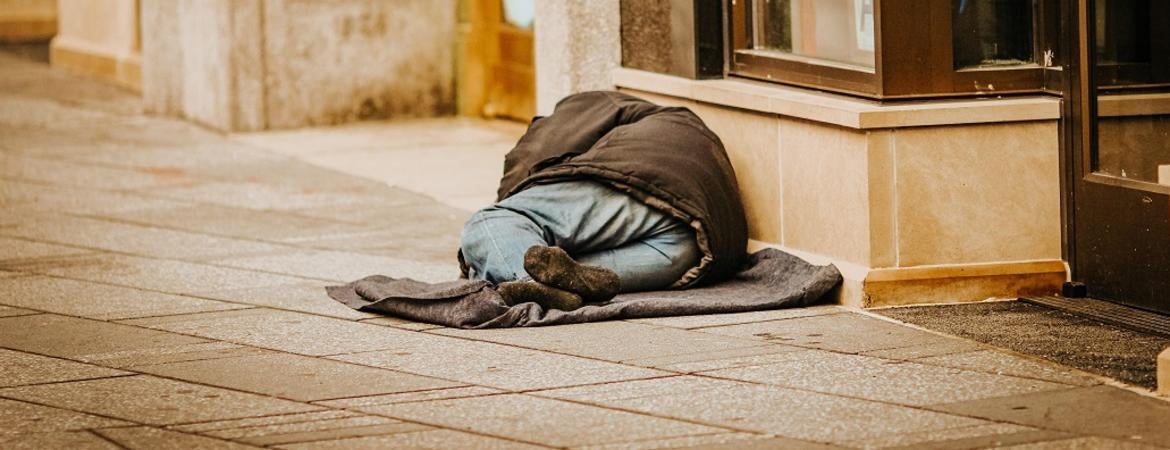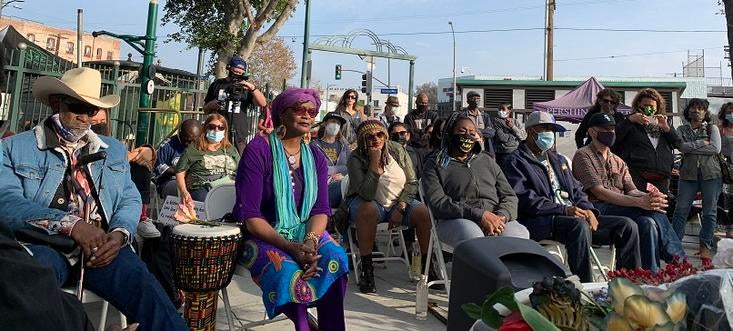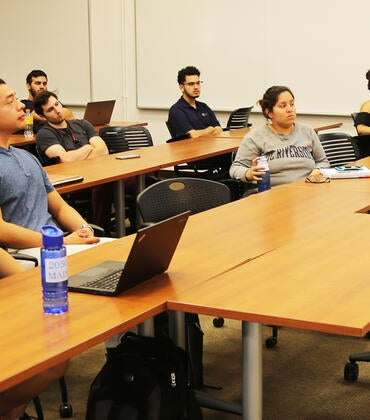
On March 3, California Gov. Gavin Newsom unveiled a plan that would compel more people into court-ordered care for mental health and substance abuse issues. Some advocates for the unhoused herald the proposal, called the Community Assistance, Recovery, and Empowerment Court, asserting it provides a long-overdue means of addressing the mental health needs of people unable to make informed care decisions. Two UC Riverside professors, however, contend the plan is an affront to civil liberties, removing life choices for poor people. They say the state's energies are better focused on addressing what they say is the root of the issue: the need for shelter and services.
Catherine Gudis is an associate professor of history at UCR, a scholar-in-residence with LA Poverty Department, and is working on a book about Skid Row history and community. She does outreach with SELAH Neighborhood Homeless Coalition. Brandon Andrew Robinson in an associate professor of gender and sexuality studies who researches the causes of and solutions to LGBTQ youth homelessness. They are the author of the book, "Coming Out to the Streets: LGBTQ Youth Experiencing Homelessness," an analysis of Robinson's work with LGBTQ youth in Texas homeless shelters and drop-in centers. Robinson has recently received a National Science Foundation grant to investigate how non-parental family members affect LGBTQ youth housing stability.
Q: Newsom’s plan would create mental health courts that would allow for more homeless people with serious mental health and addiction disorders to get treatment. It would also compel some of them to move into care. Good idea, or violation of civil rights?
Catherine Gudis: Newsom unveiled this plan earlier in the month, and though it may have faded from view in the face of wartime reporting necessities, anyone who cares about civil rights and disability rights will need to stay at the ready to respond, to stop this new version of the ongoing criminalization of poverty and to defend the rights to due process of unhoused people.
The name alone is an oxymoron—“CARE Courts”—Community Assistance, Recovery, and Empowerment Courts. Unfortunately, the plan seems to promise further empowerment of police, lawyers, and courts, rather than people in need. The basic plan as revealed thus far is for the establishment of a new branch of county courts to be set up across the state that will mandate treatment for those who appear to have severe mental health issues, with penalties that include incarceration and conservatorship for those who resist treatment. This puts health care in the hands of an already-broken criminal justice system, infusing cash into that system of caging rather than toward direct solutions to the immediate problems: housing and services.
First, the plan conflates mental illness and homelessness, ignoring systemic problems including poverty, lack of housing, and decades-long (centuries long?!) disinvestment in the community-based programs for mental health care and recovery from addiction that have been proven successful. Outreach workers, service providers, and researchers agree: coercive measures, which strip individuals of all agency, do not succeed. What people need is housing, accessible and voluntary services, and social systems that can support self-care.
Brandon Robinson: Based on my research and the youth in my study, these programs are not effective. These programs become just another way to warehouse, regulate, and place under further surveillance marginalized people and populations.
For instance, in my book, I write about a youth I call Jasper, who a judge sent to a recovery program instead of to jail. However, at this program, Jasper experienced a lot of discrimination, especially for being a gay person of color, with staff often searching his locker and questioning why he had “women’s” clothes and perfume. The staff kept writing him up for these gender transgressions, which Jasper knew was going to lead to him getting suspended from the program – a violation of his court orders – and then be sent to jail. These programs just become an extension of the carceral state and carceral systems that try to just warehouse and discipline marginalized people and keep them in constant anxiety that if they don’t comply then they will be sent to jail or prison. They do not actually help in improving the health or housing situation for people.
Q: Opponents of the plan say it’s tantamount to “round them up and lock them away.” How do you respond?
Catherine Gudis: I agree. We have no reason to believe this will work in any other way, particularly because we’ve been here before. De-institutionalization in the 1980s was in part an effort to shut down a corrupt, dysfunctional, and inhumane system that locked people away. Going back to it when we have already recognized it neither worked nor was ethical would be an evident human rights travesty.
Ananya Roy (UCLA) puts the whole Newsom plan more simply as “a war on the poor.” I understand that many families who seek means to help their relatives receive treatment have been frustrated to find themselves legally powerless to do so. I just don’t think the current plan offers an ethical, direct, or sustainable solution to their dilemmas.
Q: Will threatening to prosecute people who refuse to cooperate with mental health treatment encourage more people to comply or do you think it will backfire?
Brandon Robinson: I assume more people might go to these mental health institutions as a way to avoid charges and a criminal record. However, these institutions are just an extension of jails and other carceral institutions, so I don’t think we should see them as somehow more humane and especially not as a place of “care.” They also further legitimize carceral systems and feed more money into those systems, instead of investing money in actual housing, which would greatly help people’s mental health more than criminalizing them and warehousing them in jails, prisons, and/or mental health institutions.
Q: California accounts for more than half of the unhoused population in the country. Six of the top 10 cities in terms of homeless population are in the state. Los Angeles has more than 40,000 unhoused people. The latest Annual Homelessness Assessment Report to Congress holds that California’s homeless rate is 33 per 10,000. That compares with 17 per 10,000 for other states with moderate climates, including Florida and Texas. Does that disparity in the homeless problem have anything to do with how California approaches the problem of homelessness?
Catherine Gudis: Potentially. But I think the disparities have to do with the gross income gaps here, and the ways this translates to property, which in turn enables the rich to get even richer and the poor to become unhoused. We’ve historically had higher property and housing prices than both Florida and Texas. As our homes have continued to escalate in price, it’s had a huge impact on rentals, too.
Before the pandemic, more than a third of California renters were “cost burdened,” meaning they pay more than 30% of their income in rent. Among those are people who are extremely cost burdened, paying more than 50% of their income in rent, who are more likely to face evictions and less likely to be able to afford good food and health care. According to the National Low-Income Housing Coalition, in 2021 though poor households in all three states were extremely cost burdened, California was short by 962,000 affordable and available rental homes, while Texas was lacking 594,000, and Florida 384,000. We need $81,000 to afford a HUD-designated fair market rental, in comparison to Texas’s $45,000 and Florida’s $51,000. In all three places, earnings have not kept up with these escalating prices, leaving more people more precarious and vulnerable to becoming or remaining unhoused.
Q: The United to House L.A. initiative proposes to enact a tax on property in L.A. that sells for $5 million and up. The money raised, which proponents say would be $8 billion in 10 years, would prevent homelessness and create and support affordable housing. Thoughts?
Catherine Gudis: This is a potentially transformative, Robin Hood initiative. It was developed by grassroots and community-based organizations with boots on the ground, from tenant activist groups and housing advocates to labor unions. (They include Strategic Actions for a Just Economy [SAJE], LA Community Action Network, Inner City Law Center, Korean Immigrant Workers’ Alliance, ACT-LA, IBEW Local 11, and more.)
It aims to tax millionaires and billionaires on the sale of luxury properties in order to fund protections for existing affordable housing, create new affordable housing, and provide supportive services for low-income renters. Some 3% of property sales would be taxed between 4% and 5%. Yet the funds generated could help ease the burdens of those who have been most affected by the double whammy of stagnant wages and rising rent burdens, and who are most at risk of becoming or remaining unhoused. It also has the potential to generate tens of thousands of homes for unhoused people over the coming years. Potentially, this is also a way to recoup tax increment financing lost in the face of the demise of the Community Redevelopment Agency in California in 2012, and to tap the huge increases in property values that only the wealthiest Angelenos are able to gain from currently - widening class and racial divides. Moreover, the proposal includes citizens’ oversight and accountability, which have been sorely lacking among other housing initiatives.
Q: Are there examples of programs that effectively address both the concerns of residents and the needs and rights of the unhoused?
Catherine Gudis: Well, no matter what, housing is first and foremost, and needs to offer wraparound services, sustainable (i.e., well paid and dependable) jobs and job training, and social recovery treatment models that support building healthy lifestyles, and, as United Coalition East Prevention Project in downtown LA puts it, “challenge systemic conditions and social disparities that threaten a healthy environment.”
My friends at Los Angeles Poverty Department point me toward organizations with historical grounding like Housing Works, founded by longtime housing and mental health advocate Molly Lowery, who also started LAMP project in Skid Row in 1984, in response to the deinstitutionalization of mental health care that funneled people onto the streets. She was an early proponent of Housing First. “We do whatever it takes, for as long as it takes,” the motto of Housing Works, encapsulates the necessity for housing services not to end at the front door, but rather to continue, as an ongoing, collaborative, and needs-based process. It recognizes the complexity of interrelated human needs, and that the first but not only step is safe, affordable, and permanent housing.
Brandon Robinson: The state should provide housing for people. We have decades of research that shows Housing First works. Once in housing, people should then be able to access mental health services, if they want. But it should not be a requirement of the housing to also be in services. People should just get housing. Then we can make other services available to them if they would also like those services. We know though that Housing First is actually cheaper than cycling people through jails, social services, and other institutions. However, lawmakers refuse to do it and instead continue to invest in carceral solutions.




